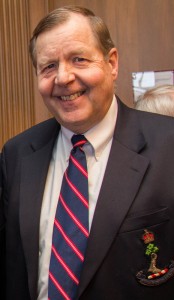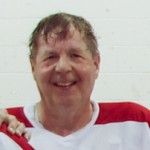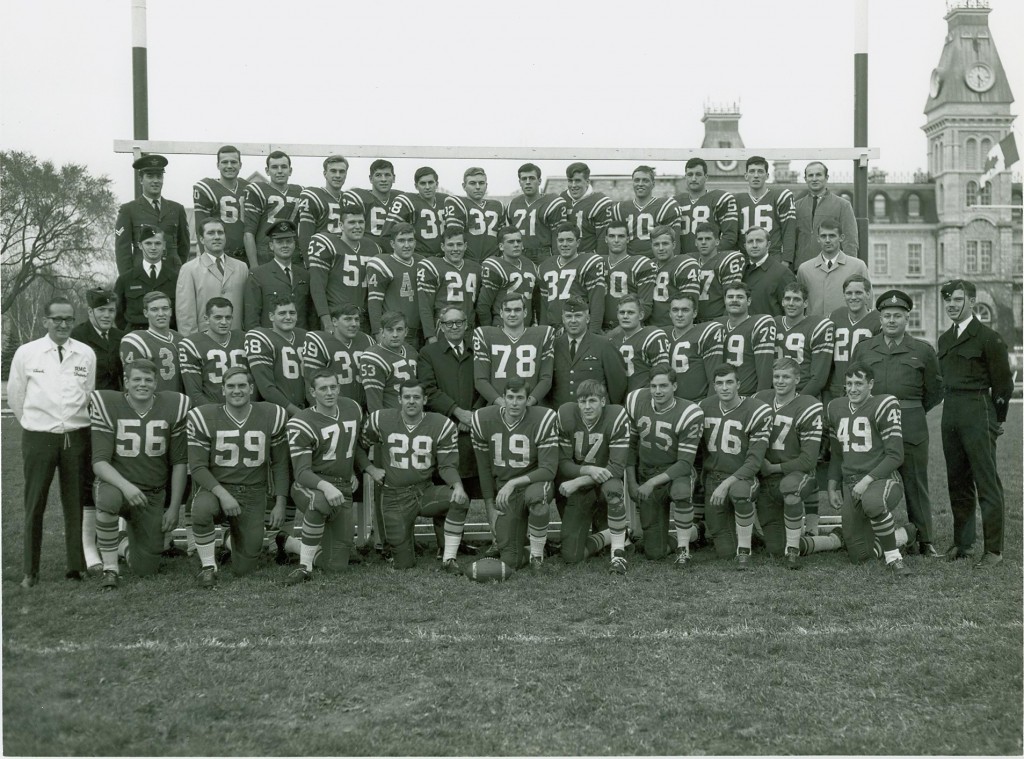
Close brush with championship still haunts 8469 Jim Simpson
By CLAUDE SCILLEY
 It wasn’t quite where Jim Simpson expected to find himself in the summer of 1972, but there he was, the navigator in a CFB Trenton-based air crew on the first Canadian Forces C-130 aircraft to fly into Vietnam with supplies for Canada’s peacekeeping contingent.
It wasn’t quite where Jim Simpson expected to find himself in the summer of 1972, but there he was, the navigator in a CFB Trenton-based air crew on the first Canadian Forces C-130 aircraft to fly into Vietnam with supplies for Canada’s peacekeeping contingent.
“We’re flying inbound,” Simpson recalled, “and the aircraft commander comes onto the intercom and says, ‘Gentlemen don’t be concerned if you hear a lot of noise; we’re getting escorted into the airport by four U.S. Marine Corps Huey gunships.’
“They’re flying along, parallel with us, with 30-calibre machine guns, and they’re just chewing up the jungle around the perimeter of the airport so nobody will jump out of the bushes and start shooting at us. That’s when, as a peacekeeping nation, your eyes get opened.
“My comment to our aircraft commander over the intercom at that precise moment was that I did not join the RCAF to get shot at in that part of the world!”
That Saigon runway was the only hot spot Simpson had to navigate as an air crewman. “It was one of those things—you’re flying into a war zone and you never really think you’d ever be there.”
It was certainly not front of mind when Simpson first entertained the notion of attending Royal Military College. Raised in Willowdale, Ont., Simpson played football at Earl Haig Secondary School, where one of his teammates was the future CFL star Bob Larose. “He was bigger, stronger and faster than anybody, so all I had to do was lob the ball in his general direction and he’d catch it,” Simpson said.
At Haig, the junior coach was a fellow named Dick Byford, who had been a Cadet Wing Commander and football player at RMC in the early 1960s. “I got introduced to the concept of RMC and football through Dick and a bit through my family,” said Simpson, whose father was a retired Air Force fighter pilot from the Second World War.
Simpson was intrigued by the possibility of playing football and hockey and pursuing a mechanical engineering degree all at the same time. “It was pretty tough to do that at any other school,” he said, and the thought of starting at College militaire royal and becoming bilingual also appealed, until he did a little research and discovered that CMR’s football team played in the Quebec CEGEP league, while RMC played against teams from such universities as Carleton, Ottawa and Bishop’s.
Simpson was able to defer his ROTP admission a year to go directly to RMC. It was at that point that Byford introduced Simpson to Doug Hargreaves, who was about to begin his second season as coach of the Redmen. “In the spring we made a trip to visit the campus,” Simpson said. “My father met Air Commodore Birchall and they hit it off. I spent half a day touring the campus with the football team captain, John Shaw.
“(It was during) that tour of the campus, and the chance to sit in on a meal with John Shaw and some of the other football players, that I got really excited about it and that cemented my desire to go to RMC.”
The fall of 1966 was the first time football recruits arrived three weeks before the rest of the first-year class, to attend training camp. Of the 10 rookies, six made the varsity team, including Simpson, as the backup quarterback and punter.
After the third game of the season, Bruce Stott, the Cadet Wing Training Officer and the first-string quarterback, got hurt. “I sort of got thrust into the breach,” Simpson said. The Redmen won Simpson’s first game, which just so happened to be on Ex-cadet Weekend. It was the first time in many years the Redmen had treated the returning alumni to a victory.
“It was quite a surreal event,” Simpson said. “The ex-cadets would primarily be on the senior staff mess side of the field and they’d watch the game for a few minutes and then they would disappear into the mess for a libation and never come back, because the team never did well (in the recent past).
“This year kind of changed things. Of course we find this out later on as players, but these ex-cadets were all hanging around the bar, and all of a sudden someone says, ‘Get the hell out here! There’s something going on; you’re missing something big.’
“The team started to be successful and it started drawing a much bigger following.”
The next year, 1967, the team had another successful year and it got better the following year, Simpson recalled, thanks in no small part to the arrival of a number of gifted athletes that fall from CMR. “We had a pretty strong offence and a reasonable defence and we started winning more than we lost, including exhibition games against bigger schools such as Guelph, Waterloo, Calgary and the University of Saskatchewan.”
By Simpson’s fourth and final year, 1969, the Redmen were at their peak. Going into a critical playoff game with Bishop’s, the players believed they had a legitimate chance of playing in the College Bowl, Simpson said. “We were the better team.”
Among the aforementioned group of CMR cadets who arrived a year earlier was a man who was the team’s middle linebacker in 1969, Greg McDonald. “Greg was the only interior linebacker in the league who could stop Larry Smith,” Simpson said, referring to the Bishop’s back who would go on to a distinguished career in the CFL.
“In the critical game, Greg had some separated ribs but he was playing,” Simpson continued, “but he got spear-blocked on the first play on the second half and (trainer) Chuck Badcock took him out of the game. The first play after Greg got hurt, we lost Sonny Marche, our strong side linebacker, so in two plays we lost our two key interior defensive guys.
“On the next play, Larry broke from the four-yard line and went all the way. He ran for three touchdowns in the second half and put 230 yards on the board. We lost the game by a few points.”
Bishop’s went on to play for the Central Canada championship against Windsor, but lost. “All of us felt that we had a better team and probably could have come out victorious” in that game, Simpson said, and move one step closer to the College Bowl.
“It still haunts me. (As) quarterback, if you have a career day you can overcome some of these deficiencies that are injury-related. I didn’t have a career day. I didn’t have a bad day, but I didn’t have a career day.
“The emotion is still there. Thirty-odd years later Doug and I would hug each other, and I keep apologizing.”
From RMC, Simpson was posted to the navigation training course in Winnipeg, and he and two former classmates, Claude Naue and Russ Crum, joined the senior St. Vital Bulldogs, the reigning Canadian senior amateur champions. After a game in Thunder Bay, where Simpson, playing defensive back, intercepted three passes—returning two of them for touchdowns—he was called on the carpet by his ANAV course director, who took a dim view of one of his students risking his health playing tackle football. The brash young lieutenant, knowing that it was common, if not encouraged, for military men to play senior hockey in the communities where they were posted, resisted.
He told his captain he was going to keep playing. “Just to prove my point, (I said) I’m going to finish first in this course.’
“I continued to play football, and I finished first in the course. I got away with it.”
Posted to 436 Squadron at CFB Trenton, Simpson continued to play amateur football, and was player-coach for the base team in a four-team eastern Ontario league that included teams from Rockcliffe, Uplands and the RCMP.
After a couple of years, Simpson learned through the grapevine that the air navigator staff position at RMC was about to be rotated, “so I quickly started putting the pieces in place to get transferred there.” The plan was to go back as a squadron leader and help coach Bob Swan with the football program. Swan pitched the idea to the commandant, Brig.-Gen. Bill Turner, who was receptive and when the appointments were announced in the spring of 1973, Simpson was bound for RMC. At the age of 26, just three years and three months after graduating in 1970, Simpson was the youngest ex-cadet ever to come back and serve as a squadron commander.
“My passion to do that came from mixing with non-RMC graduates in the service who complained about some of the arrogance that they saw in what were known as the ring-knockers,” Simpson said. “My philosophy has always been that you do your talking on the field. My sports heroes were people like Gordie Howe, Bobby Orr and Bill Symons, who played hard and never talked about it afterwards.
“I never wore an ex-cadet ring in the mess. Nobody knew who I was or where I came from. You gain respect in how you deliver, on the job and in the field. Because I kept hearing all these complaints, I got upset. One of my objectives was to go back and not inly influence the football program, but also get a chance to mentor third- and fourth-year cadets on the life and challenges of being in the real service, and provide them with solid advice and counsel on how to be successful, in the military and in life in general.”
Simpson’s first mission as a squadron commander involved taking a colour party to Guatemala in August of 1973 to help celebrate the 150th anniversary of the Guatemalan military academy.
“If you talk to any of them today, one of the highlights of their military life is probably going to Guatemala as a cadet and being able to mix and mingle with students from Annapolis, the Air Force Academy, West Point, Sandhurst, Cranwell—there were probably 30 different military colleges represented in that event. They all went on parade together … it was a great trip.”
Simpson served the college as public affairs officer during its centennial year before taking a leave of absence to complete his MBA at Queen’s, where he was reunited once again with Doug Hargreaves. After briefly considering whether to use his final year of intercollegiate eligibility to play with the Gaels that fall, Simpson chose instead to serve on Hargreaves’ staff, coaching the defensive backs.
“You always want to test yourself at the next level,” Simpson said. “I was bigger, stronger, smarter than I was when I was 21, and had a lot more football under my belt, but you know how Doug is; he doesn’t like to push things. He said let’s both go away for a week and think about it.”
That weekend, as they watched a CFL game on TV in the Hargreaves’ living room, eventually the conversation made its way to the matter at hand. “I said, ‘You know, I’m taking q leave of absence without pay for a year. If I get hurt I’ll be the stupidest sonofabitch in the world. I’d better coach.’ Doug said, ‘Good decision.’
“The regret is that when I walked out on the training field, I realized that my skills were equal to or better than a lot of the Gaels football players. I could easily have fit it in, but likely would not have been able to carry the academic load and the playing load, so it was a good decision.”
When it was time to go back to work for the DND after graduation, Simpson had a “disconnect” with his career manager over his next posting. He had designs on a leadership career in the service, while his boss envisioned him exclusively in the navigation field. “I was challenged by him to take it or leave, so I took them at their word, resigned my commission, and joined Deloitte Touche in the general management consulting service.”
From there Simpson worked for Northern Telecom, then with one of Nortel’s distributors, then spent the next 25 years in the executive-search business, eventually engaging in startups, executive and management recruiting and general management consulting. With Don Cooper, his partner on his fourth-year engineering thesis at RMC, Simpson co-owns Simpson Environmental, a wastewater and waste-to-energy business his grandfather started in 1959.
He still maintains his own private consulting practice.
Divorced, with three daughters—Lindsay lives in Vermont, where she’s a health and wellness consultant for the state education department and a gifted endurance runner; Meghan works in the financial services sector in Barrie, Ont., and Jessica, a paramedic, lives in Horseshoe Valley, northwest of Barrie—and four grandchildren, Simpson remained active in college affairs after he left the military, actively recruiting scholar-athletes to RMC. He spent many years on alumni executive boards, largely dealing with fundraising, and, with Lloyd Beverley, Joe Day and Tom Marshall, helped to establish the framework for the RMC Club of Canada Foundation as it exists today.
He has also stayed active in football, bird-dogging recruits in York Region for Queen’s and for his cousin, Stu Lang, the Queen’s grad now coaching the Guelph Gryphons.
 He remains steadfastly supportive of RMC.
He remains steadfastly supportive of RMC.
“The kids, when they’re at RMC, that’s when they can really learn what it’s like to be part of a team, and that the sum of the parts is a lot stronger than the individual parts,” Simpson said. “I had a lot of fun (working with cadets). Squadron commander is a great job.”
Ed: Photo left – Jim Simpson following a hockey game with first year cadets this most recent Reunion weekend. The two football team photos above had no record of the particular seasons. We invite comments to identify the years.



